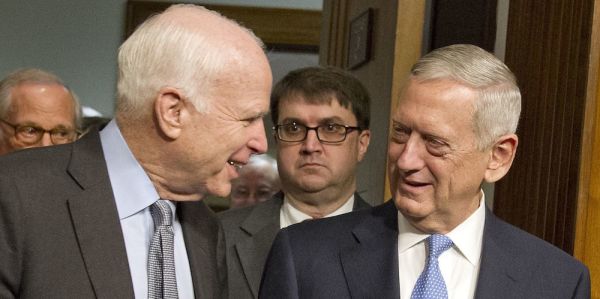

More and more U.S. military personnel are dying far from active battlefields — and Secretary of Defense James Mattis is on a mission to figure out why.
Mattis told reporters on Sept. 18 that he and other Pentagon officials are examining the link between military budget levels and the alarming rise of non-combat deaths among the service branches.
“I am not concerned right now that we are rewarding the wrong behaviors, but we are going to find out if that’s the case and we are going to look at that,” he added. “I am not willing to say right now that there is a direct line between sequestration and what has happened. I am willing to say … we are going to take a very close look at that.”
At least 56 service members have been killed or injured in non-combat incidents since the beginning of June, according to an analysis from Military Times — incidents that include operational mishaps like the back-to-back collisions of the USS Fitzgerald and USS John S. McCain in the Pacific over the summer; training accidents like the KC-130 crash that left 16 Marines dead in July, the AAV fire that hurt 15 at Camp Pendleton last week, and the range blast that killed one and hurt 7 at Fort Bragg, also last week; and even civilian expos, which have continued to claim the lives of U.S. special operations forces in parachute accidents.
According to Sen. John McCain, the actual number of non-combat deaths and injuries may be closer to 100.
“My friends, more of our men and women in uniform are now being killed in totally avoidable training accidents and routine operations than by our enemies in combat,” McCain said. “Where is the outrage about this? Where is our sense of urgency to deal with this problem?”
This alarming trend in non-combat fatalities appeared to climax in September, as Military Times points out, with two service members were killed and 26 seriously injured in three separate training incidents at military facilities across the country. Most recently, 15 Marines were grievously injured after their amphibious-assault vehicle burst into flames on Sept. 13.
Most of the training mishaps occurred in the Navy and Marine Corps, which have seen dramatic increase in Class A mishaps — non-combat accidents that result in fatalities or a certain damage cost — over the last several years, both tied to an uptick in operational tempo for the two branches. For the Navy, those mishaps are concentrated on surface warships, like the Arleigh Burke-class destroyers doing double-duty in the Pacific to keep an eye on North Korea and China; for the Corps, it’s been mostly aviation operations, essential to deploying Marines quickly downrange. (Army mishaps have remained relatively stable for the last few years, while Air Force mishaps are negligible at best.)
Related: The KC-130 Crash Is Just The Latest Tragedy In The Marine Corps’ Worsening Aviation Mishap Crisis »
Most service branches have attributed the apparent uptick in non-combat deaths to a variety of human errors, from training deficits to equipment maintenance — all of which, according to military leaders, have been exacerbated by 2013 budget sequestration deal. It’s the U.S. government’s “failure over the last eight years to make sure our military is prepared, equipped, trained,” as McCain told CBS’s “Face The Nation” on Sept. 17, that defines the DoD’s accident crisis.
Concerns over the relationship between budget cuts and non-combat deaths prevail in the House as well. “We have too few planes that can fly, too few ships that can sail and too few soldiers who can deploy,” Texas Rep. Mac Thornberry, chairman of the House Armed Services Committee, wrote in the Washington Post on Sept. 7. “A total of 185 service members lost their lives in non-combat accidents over the past three years — more than four times as many as the 44 who were killed in combat.”
While branch officials have moved to hold commanders accountable for non-combat fatalities, as evidenced by the sacking of high-ranking 7th Fleet officers, Thornberry pointed the finger squarely at lawmakers. “It is Congress’s responsibility to provide for the common defense,” he wrote. “Regrettably, over the past six years, funding for our military has been held hostage by members of both parties.”
It seems that Mattis just gave lawmakers like McCain and Thornberry the signal they needed to take action. Mere hours after Mattis put sequestration in the crosshairs, the Senate approved a $700 billion defense policy package, significantly more than both the $603 billion defense budget laid out by President Donald Trump in May and the $640 billion increase kicked around by the House and Senate Armed Service Committees in June. Among its key provisions: a major chunk of cash to fill essential training gaps and maintain existing equipment, spearheaded by McCain.
Related: The Shrinking Military Budget Is Killing Our Readiness »
Despite growing concerns over sequestration’s human toll, Mattis still managed to eke out a silver lining in typically Mattis fashion. The root of the non-combat fatality problem, he said, isn’t just a product of aging airframes and poorly-trained personnel, but a larger function of the armed forces’ “can-do” approach to finding solutions even in the face of scarce resources.
American troops are, in short, too legit to quit.
“I would say, having some association with the U.S. military, we’re almost hard-wired to say ‘can-do,’” Mattis told reporters on Sept. 18. “That is the way we are brought up, routinely, and in combat, that is exactly what you do even at the risk of your troops and equipment and all.
But, he added, “there comes a point in peacetime where you have to make certain you are not always saying we’re going to do more with less.”
WATCH NEXT:
